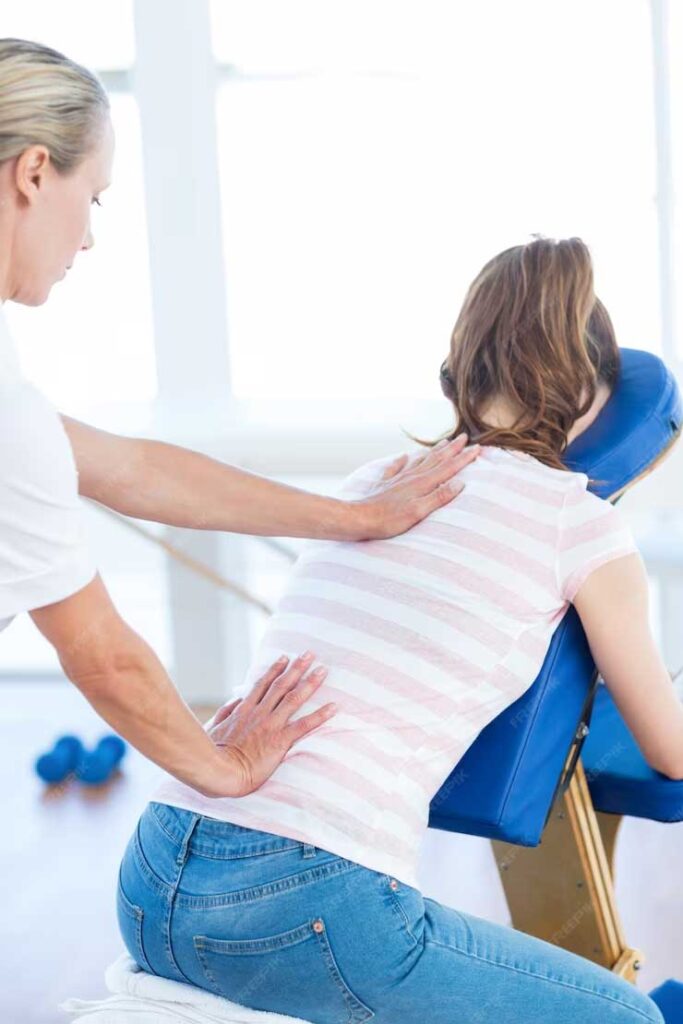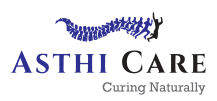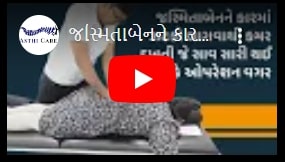Sciatica Pain Treatment in Surat
We excel in providing non-surgical solutions for alleviating sciatica pain. If you’re grappling with the distressing impact of sciatica, you’ve found the optimal solution. We comprehend the hurdles sciatica presents in your everyday life, from persistent discomfort to intense pain shooting down your leg. Our team of seasoned professionals is committed to delivering top-notch care and ensuring relief for your condition.


Understanding Sciatica
Sciatica is characterized by pain that radiates along the path of the sciatic nerve, typically affecting one side of the body. This pain can range from sharp and burning to tingling, usually initiating in the lower back and extending down the leg. It’s essential to recognize that sciatica is not a condition in itself but a symptom of an underlying issue, such as a herniated disc or spinal stenosis. Understanding and addressing the root cause is key to effective management and relief from sciatic pain.
Sciatica Treatment without Surgery
Physical Therapy: Strengthening and Healing
Physical therapy is important in the non-surgical management of sciatica. Collaborating with a skilled physical therapist allows for the creation of a tailored exercise program that targets the strengthening of muscles supporting the spine. These exercises work to relieve pressure on the sciatic nerve and foster the healing process.
Asthi Care: Aligning Your Spine
Asthi care focuses on spinal adjustments to enhance alignment and alleviate irritation to the sciatic nerve. Our non-invasive approach aims to offer relief and can contribute to preventing the recurrence of sciatica episodes.
Epidural Steroid Injections: Targeted Pain Relief
Epidural steroid injections deliver anti-inflammatory medication directly to the affected area, effectively reducing pain and inflammation. Although not a permanent solution, these injections can offer substantial relief, enabling you to participate more comfortably in physical therapy and other treatment modalities.
Acupuncture: Restoring Balance
Acupuncture, an age-old practice, can be a successful treatment for sciatica by stimulating specific points in the body. Regular acupuncture sessions have proven beneficial for many individuals, providing relief from pain and enhancing overall mobility.


Heat and Cold Therapy: Natural Relief
Switching between heat and cold packs can effectively diminish inflammation and alleviate sciatic pain. The application of heat helps relax tense muscles, while cold therapy can numb the area and reduce swelling, offering a dual approach to soothing discomfort.
Lifestyle Changes: Supporting Healing
Incorporating lifestyle changes into your routine can play a pivotal role in recovering from sciatica. Sustaining a healthy weight, prioritizing good posture, and minimizing prolonged sitting, weight lifting and forward bending are all proactive measures that can alleviate symptoms and reduce the likelihood of future episodes.
Pain Medication: Temporary Relief
Over-the-counter pain relievers or prescribed medications can offer temporary relief from sciatica pain. However, it is crucial to use these under the guidance of a healthcare professional to mitigate the risk of dependence.
Rest and Relaxation: Allowing Healing
Sometimes, all your body needs is rest. Taking a break from strenuous activities and giving your body time to heal is essential for recovering from sciatica.
FIND ANSWERS BELOW
Sciatica - FAQs
Sciatica is most commonly caused by a herniated disc, which puts pressure on the sciatic nerve. Other causes include spinal stenosis, spondylolisthesis, and piriformis syndrome.
Most common cause of sciatica is a herniated disc, where pressure is exerted on the sciatic nerve by disc. Additional factors contributing to sciatica include spinal stenosis, spondylolisthesis, and piriformis syndrome
In many cases, sciatica can improve and resolve on its own without the need for surgery. The body's natural healing processes, combined with conservative treatments such as rest, physical therapy, and medication, often contribute to the reduction or elimination of sciatic pain over time. However, the duration of recovery can vary from person to person, and some individuals may require more extensive interventions depending on the underlying cause of their sciatica.
No, Surgery is typically considered a last resort for treating sciatica, and healthcare professionals often explore conservative, non-invasive treatments first. Many individuals do find relief through methods such as physical therapy, medications, lifestyle adjustments, and other non-surgical approaches.
Recovery time varies from person to person, but with the right treatments and lifestyle adjustments, most people experience significant improvement within a few weeks to a few months.
Certain exercises, like heavy lifting or intense twisting motions, can exacerbate sciatica symptoms. Consult a healthcare professional or physical therapist for a tailored exercise plan.
Secondary conditions:
- Carpal Tunnel Syndrome
- Chronic Neck Pain
- Degenerative Joint Disease
- Disc Bulges and Herniation
- Knee Pain
- Low Back Pain
- Mid back Pain
- Numbness and Tingling (hands and feet)
- Neck Pain
- Radiculopathy
- Scoliosis
- Sciatica
- Shoulder and Arm pain
- Sports Injuries
- Spinal Alignment/Cervical Curve
- Spinal Pain, Stress
- Temporomandibular Joint
While it may not be entirely preventable, maintaining a healthy lifestyle, including regular exercise and good posture, can reduce the risk of developing sciatica.
Secondary conditions:
- Carpal Tunnel Syndrome
- Chronic Neck Pain
- Degenerative Joint Disease
- Disc Bulges and Herniation
- Knee Pain
- Low Back Pain
- Mid back Pain
- Numbness and Tingling (hands and feet)
- Neck Pain
- Radiculopathy
- Scoliosis
- Sciatica
- Shoulder and Arm pain
- Sports Injuries
- Spinal Alignment/Cervical Curve
- Spinal Pain, Stress
- Temporomandibular Joint



